
Introduction
For the Russian people Lake Baikal is a natural treasure, for the rest of the people of the world – it’s a Well of the Planet Earth. Located in Siberia near the Mongolian border, and surrounded by mountains, forests and wild rivers, Baikal is an immense and breathtaking area of physical beauty. Baikal holds twenty percent of the earth’s fresh water and harbors more endemic species of plants and animals than any other lake in the world. Fed by 336 rivers and streams including the Angara, Barguzin, Selenga, the Upper Angara the lake holds fifty species of fish including bullhead, sturgeon and omul. A glimpse into the lake’s clear water is enough to convince anyone that nature not only exists in Siberia, it flourishes. The lake’s surrounding wild mountains and rivers make the Lake Baikal region an ideal area for engaging in an array of outdoor pursuits including hiking, climbing, whitewater sports, skiing and nature photography.
There are also many regional cultural attractions. Today, as in the past, Baikal remains a crossroads of cultures where native Soyuts still herd reindeer and Buryat people maintain many of their old traditions as well as Old Believers who found their shelter here centuries ago still manage to keep their amazing customs. It is hard to imagine that these wilderness areas and exotic cultures are only a five to seven hour jet ride from Moscow or Khabarask.
The Itinerary Description
Day 1
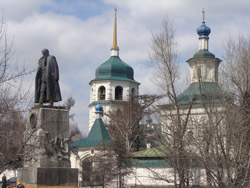 Welcome to Irkutsk - “Paris of Siberia”, capital of its great Eastern part –Siberia’s Microcosm and the gateway to “Siberia’s” Pearl - Lake Baikal! Welcome to Irkutsk - “Paris of Siberia”, capital of its great Eastern part –Siberia’s Microcosm and the gateway to “Siberia’s” Pearl - Lake Baikal!
Upon arrival we meet you with professional bi-lingual guide holding “Absolute Siberia” sign assist with the luggage and provide transfer to your hotel.
After check and some time at leisure we’ll go on a guided sightseeing tour of Irkutsk. During the tour today we’ll visit the city’s historical center and its most atmospheric sights, including Znamenskaya Orthodox Cathedral, noted for its original iconostasis, grave of the so-called “Russian Columbus” Grigory Shelekhov who was an early Russian explorer of Alaska and graves of the Decembrists-revolutionaries banned to Siberia after an ill-fated attempt in 1825 to overthrow the Russian tsar.
After exploring the city we shall have lunch in the downtown restaurant. The rest of the day is yours to explore it on your own and with your local guide’s assistance. 
Day 2
After breakfast we check out from the hotel for a coach transfer to Bolshoye Golustnoye village ( 110 km, 2 hours 30minutes drive) with stop en route to see the Buryat log-yurts near Shantuysky bridge named after the old shaman who was buried here. The surrounding area here is considered the most ecologically lean of lake Baikal area , and not in vein it was chosen by famous Irkutsk expert on medicinal herbs and plants as his base camp place.
Upon arrival in the village of Bolshoye Goloustnoye accommodation in the families (sanitary facilities outside). Lunch all together in one family.
After lunch proceed on a guided walk to the Goloustnyaya river delta and further to the cape along the shore of Lake Baikal, visit legendary The Wonder-maker Orthodox Church. On return back to the village enjoy Russian banya – (steam bath) and dinner. Overnight in your families.
Day 3
After breakfast we shall hike to picturesque Sukhoye Ozero (Dry Lake) often called as the Petty Lake is located 3 km away from the village, close to the tourist camp in Semenovka Hollow. The hike proceeding along the ecological path of the national park ( set up in 1986) through the birch tree grove of Ushkanyi Hollow will introduce to you some species of local flora and fauna. A remarkable feature of the Dry lake that gave the name to it is that the water level in this small lake is not stable, the basin sometimes has nearly no water at all. The lake was entered into special registry of geological nature landmarks of Irkutsk region. Upon reaching the Ushkanyi Hollow you will enjoy gorgeous landscapes of lake Baikal. Also during the hike you can even go bathing in Lake Baikal in the Semenikha bay where the water is much warmer than in most parts of lake Baikal. Lunch shall be served here prepared over the camp-fire and featuring omul-fish that will be smoked in your presence. Then we return back to the village.
This dinner we will enjoy Burayt national cuisine featuring the Burayat pozy (big dumplings), lam and other tasty and home made entrees. And after dinner we will 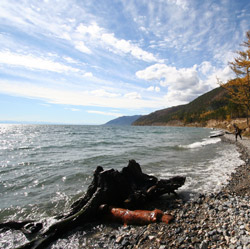 have local Buryat folklore performance with lots of singing and entertainment. have local Buryat folklore performance with lots of singing and entertainment.
Overnight in the families.
Day 4
After breakfast we leave our families and complete with the luggage get on board of the boat to undertake a boat ride (mini-cruise) to the Listvyanka village located in the mouth of the Angara river from Lake Baikal (3/5 hour boat ride) .
Russo-Siberian cusine shall be served for lunch on board.
Around 2 p.m. we’ll get to Listvyanka, check in at Arabesque Guest Lodge. Then visit Baikal Ecology Museum and see the Baikal aquarium featuring besides alive fishes also a couple of the lakes’s onle mammal – Baikal fresh water seals.
Then those who want can walk to the popular functioning St.Nicolas-the-Miracle-Worker Russian Orthodox Church built of wood without use of any nail. Here one can see outstanding altar section with beautiful iconostasis as well as see how the local people worship their Orthodox faith.
Dinner shall be served at the restaurant.
Overnight at the guest lodge.
Day 5
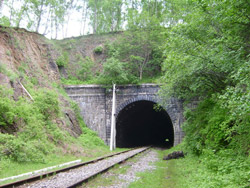 After breakfast to be served at 08:00 we check out from the hotel and get our transfer to the boat station to take a ferry for a 30-min. ride to the Port of Baikal. Here we disembark at the port to take the tourist train for a ride along the section of the Round Baikal Railway called as “The Golden Buckle of Steel Belt of Russia”, because the last Russian tsar built it at enormous cost. Now this section of the railway not used any more by the Trans-Siberian is considered to be the feast of railway engineering and most spectacular historic railroad of Russia still preserved and functioning. We will ride to Sludyanka that gonna take us more than 7 hours with 5 stops on the way near most spectacular and interesting sights of this unique railway and natural sight . In about 2 hours when the train stops for 40 minutes in a picturesque place and near the village we will have our lunch served as picnic (box lunches with hot tea/ coffee and drinks offered). After breakfast to be served at 08:00 we check out from the hotel and get our transfer to the boat station to take a ferry for a 30-min. ride to the Port of Baikal. Here we disembark at the port to take the tourist train for a ride along the section of the Round Baikal Railway called as “The Golden Buckle of Steel Belt of Russia”, because the last Russian tsar built it at enormous cost. Now this section of the railway not used any more by the Trans-Siberian is considered to be the feast of railway engineering and most spectacular historic railroad of Russia still preserved and functioning. We will ride to Sludyanka that gonna take us more than 7 hours with 5 stops on the way near most spectacular and interesting sights of this unique railway and natural sight . In about 2 hours when the train stops for 40 minutes in a picturesque place and near the village we will have our lunch served as picnic (box lunches with hot tea/ coffee and drinks offered).
When we reach the station of Sludyanka where we will get off the train and take a transfer to Utulik Settlement, located on the eastern shore of Lake Baikal.
About 8 p.m. we arrive in Utulik . Accommodation in “Cedar” Hotel. Dinner and overnight.
Day 6
We will spend this time exploring the surroundings. First and before lunch we will undertake a 2-hour easy hike to the waterfalls. From top of the mountains we shall enjoy great panoramic views and take wonderful pictures.
After lunch in the restaurant of the hotel we will have a guided excursion by coach to warm lakes, located in a very picturesque natural setting about 40 km from Utulik, near the beach of fine sand.
Here you can try swimming in the lake’s water, boating or can take a catamaran for rent.
Return to the hotel to take a shower, have some rest before departure to Sludyanka.
In the evening transfer from Utulik on mini-buses to Sludyanka to board late evening train to Ulan-Ude. Overnigt on the train.
Day 7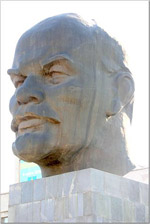
 Arrival in Ulan Ude – the capital city of Buryat Republic. Transfer to Zagan Morin or Gesser tourist class hotels. Check in. Breakfast. Have some time at leisure before lunch. Arrival in Ulan Ude – the capital city of Buryat Republic. Transfer to Zagan Morin or Gesser tourist class hotels. Check in. Breakfast. Have some time at leisure before lunch.
After lunch we shall proceed by coach for half-day tour to visit Ivolginsky Datsan (Buddhist Temple) located in a picturesque and peaceful place named Ivolga, 23 kilometres from Ulan-Ude. Tour of the Lamaistic Temple here given by huvarak (monk student).
After touring the Datsan we will we return back to Ulan Ude and visit the central square of the city famous for the Head of Lenin – the world’s largest sculptured head of Lenin. Then we return back to the hotel for dinner and overnight.
 Ivolginsky Datsan was the only Buddhist monastery tolerated by the Communists, and is said to have more than 1,000 Buddha statues, from small ones to the one that is 2 meters high. In its place is a gleaming three-story temple crowned with yellow eaves and guarded by stone tigers, caretaker of the heart of Buddhism in Russia. Ivolginsky Datsan opened an institute of Buddhist learning on its grounds that has expanded to accommodate 110 students. There are also a library, hotel, the philosophic faculty - Choyra, building of the Buddhistic University - Dashy Choihorlin, museum of monuments of Buryat art, sacred tumbs -suburgans, some service buildings and houses for lamas there. Nowadays The Ivolginsky Datsan is considered to be the center of Buddhism in Russia. It attracts a lot of tourists and believers. Ivolginsky Datsan was the only Buddhist monastery tolerated by the Communists, and is said to have more than 1,000 Buddha statues, from small ones to the one that is 2 meters high. In its place is a gleaming three-story temple crowned with yellow eaves and guarded by stone tigers, caretaker of the heart of Buddhism in Russia. Ivolginsky Datsan opened an institute of Buddhist learning on its grounds that has expanded to accommodate 110 students. There are also a library, hotel, the philosophic faculty - Choyra, building of the Buddhistic University - Dashy Choihorlin, museum of monuments of Buryat art, sacred tumbs -suburgans, some service buildings and houses for lamas there. Nowadays The Ivolginsky Datsan is considered to be the center of Buddhism in Russia. It attracts a lot of tourists and believers. |
Day 8
After breakfast we shall tour the city of Ulan Ude and visit the most remarkable city’s sights including the Church of Odigitria and a walking excursion through the old central part with richly carved wooden house that once belonged to rich merchants.
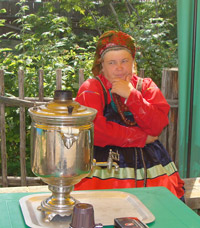 After lunch we shall depart to Tarbagatay, the village of Old Believers – descendants of those Russian orthodox people who opposed in the 17-th century Nikon’s church reforms and escaped to Siberia. The cultural space and oral culture of the “Semeiskyie” –Old Belivers of this village was proclaimed by UNO Educational, Scientific, and Cultural Organization a Masterpiece of the Oral and Intangible Heritage of Humanity. After lunch we shall depart to Tarbagatay, the village of Old Believers – descendants of those Russian orthodox people who opposed in the 17-th century Nikon’s church reforms and escaped to Siberia. The cultural space and oral culture of the “Semeiskyie” –Old Belivers of this village was proclaimed by UNO Educational, Scientific, and Cultural Organization a Masterpiece of the Oral and Intangible Heritage of Humanity.
The Old Believers dressed in their bright folk costumes, wearing large amber necklaces shall meet us near the village and take for a short hike up to the sacred Omulevaya Mountain. On top of this mountain from which there’re great vistas of the surrounding area and riverside a group of the Old Believers from Trabagatay village shall give us a brief introduction to their culture. Then we proceed to the village Cultural Center to see the great folk concert, learn about the customs of Old Believers, and take part in their “match-making and bride & groom games” in which some of you may be welcome to participate.
After the show we will follow the female leader of “semeiskiye” to her house for a Gala Dinner at Galina’s home. The dinner besides featuring tasty home made traditional meals of the Old Believers will be also followed by a number of songs performed by the hosts. Certainly, with the help of your lovasl guides you will have an excellent opportunity to talk to and learn much from the “semeiskiye” people.
After fantastic time that we would have spent in Tarbagatai we return back to Ulan Ude for overnight at the hotel.
Day 9
Breakfast.Transfer to the airport
 Brief information about Bolshoye Goloustnoye village: Brief information about Bolshoye Goloustnoye village:
The village was founded in 1673 by a Buryat person named Soriel who moved with his family to the delta of the river. He chose this place for the residence since , as he said, “there meat could be bagged without knife, fish caught without tackles and wood without axe”. Then in 1701 a Russian named Andrei Osharovsky arrived here and built his log-cabin near the place where now the Orthodox chapel is located. Later he sold his log cabin to the monks of the Posolsky Monastery ( eastern shore of Lake Baikal).
In 1740 a Russian exile named Pavel Strekalovsky arrived in here and bought the log-cabin from the monks. Assisted by the Buryat people he built up the boats to develop commercial fishing and carry goods cargo across the lake. In winter he would still be engaged in merchandise transportation acroos the lake on the ice with horse-drawn sleighs. He managed to maintain very friendly relations with local Burayt people, taught them how to grow potatoes and wheat.
After arrival of merchant Ivan Belozertsov in the Semenovka Hollow (close to the village) the foundation was laid to 10 new households of his large family. But in 1949 during the 2-nd collectivization campaign under Stalin these households were removed to the village of Bolsjoye Goloustnoye where few of them still remain. But on the edge of the village there’s still a cross to be seen that used to mark the land plots of the Belozertsov family.
The village was conveniently located on cross roads of local trade routes, and was a popular destination. Russian Ambassador to China in the 18-th century used to pass by this village, as well as it was visited by Protopo Avaakuum and the founder of anarchism – Prince Kropotkin, other prominent Russian figures.
The village was settled down by Russian of pure Orthodox faith. Since many of the village people depended on fishing in the sea the most worshipped Orthodox Saint was St. Nicolas-The-Miracle-Worker. A legend says that a famous wonder Icon of St. Nicolas miraculously appeared here at the ancient place of shamanist believers. Where it had appeared the monks placed the Cross in the 17-th century, and then in 1701-1703 the first Orthodox Chapel was built here on request of the Cossacks. But it was deliberately burnt down by the communists in 1947. The first Orthodox church was built in the village on February, 05, 1867, in honour of St.Nicolas of the Greek city of Mira ( the Wonder-maker). It worth noting that in the construction of the church took part Russian, Buryat and Evenk people. Since 1937 the church was not used for the Orthodox services and then later ion 1941 was shut down on order of the local Soviets and the church left without “master” would soon dilapidate . After the collapse of the Soviet Union the funds were raised locally and internationally to restore the church.
The village is also the place of one of the oldest meteorological stations on lake Baikal which has been operating since 1897. The first primary school was open here back in 1897.
As per the data of 1893 the population of the village was 102 people, in 1923 it consisted of 100 people belonging to the Strekalovsky family, 83 – to the Belosertsov family and 25 other people. In the vicinity of the village lived around 480 Buryat people. At time present the population of the village makes up more than 700 people. |
To book this tour from the US,Canada, Australia please contact: Aaltje van Zoelen at info@traveleastrussia.com
|




 Welcome to Irkutsk - “Paris of Siberia”, capital of its great Eastern part –Siberia’s Microcosm and the gateway to “Siberia’s” Pearl - Lake Baikal!
Welcome to Irkutsk - “Paris of Siberia”, capital of its great Eastern part –Siberia’s Microcosm and the gateway to “Siberia’s” Pearl - Lake Baikal!
 have local Buryat folklore performance with lots of singing and entertainment.
have local Buryat folklore performance with lots of singing and entertainment.  After breakfast to be served at 08:00 we check out from the hotel and get our transfer to the boat station to take a ferry for a 30-min. ride to the Port of Baikal. Here we disembark at the port to take the tourist train for a ride along the section of the Round Baikal Railway called as “The Golden Buckle of Steel Belt of Russia”, because the last Russian tsar built it at enormous cost. Now this section of the railway not used any more by the Trans-Siberian is considered to be the feast of railway engineering and most spectacular historic railroad of Russia still preserved and functioning. We will ride to Sludyanka that gonna take us more than 7 hours with 5 stops on the way near most spectacular and interesting sights of this unique railway and natural sight . In about 2 hours when the train stops for 40 minutes in a picturesque place and near the village we will have our lunch served as picnic (box lunches with hot tea/ coffee and drinks offered).
After breakfast to be served at 08:00 we check out from the hotel and get our transfer to the boat station to take a ferry for a 30-min. ride to the Port of Baikal. Here we disembark at the port to take the tourist train for a ride along the section of the Round Baikal Railway called as “The Golden Buckle of Steel Belt of Russia”, because the last Russian tsar built it at enormous cost. Now this section of the railway not used any more by the Trans-Siberian is considered to be the feast of railway engineering and most spectacular historic railroad of Russia still preserved and functioning. We will ride to Sludyanka that gonna take us more than 7 hours with 5 stops on the way near most spectacular and interesting sights of this unique railway and natural sight . In about 2 hours when the train stops for 40 minutes in a picturesque place and near the village we will have our lunch served as picnic (box lunches with hot tea/ coffee and drinks offered). 
 Arrival in Ulan Ude – the capital city of Buryat Republic. Transfer to Zagan Morin or Gesser tourist class hotels. Check in. Breakfast. Have some time at leisure before lunch.
Arrival in Ulan Ude – the capital city of Buryat Republic. Transfer to Zagan Morin or Gesser tourist class hotels. Check in. Breakfast. Have some time at leisure before lunch.  After lunch we shall depart to Tarbagatay, the village of Old Believers – descendants of those Russian orthodox people who opposed in the 17-th century Nikon’s church reforms and escaped to Siberia. The cultural space and oral culture of the “Semeiskyie” –Old Belivers of this village was proclaimed by UNO Educational, Scientific, and Cultural Organization a Masterpiece of the Oral and Intangible Heritage of Humanity.
After lunch we shall depart to Tarbagatay, the village of Old Believers – descendants of those Russian orthodox people who opposed in the 17-th century Nikon’s church reforms and escaped to Siberia. The cultural space and oral culture of the “Semeiskyie” –Old Belivers of this village was proclaimed by UNO Educational, Scientific, and Cultural Organization a Masterpiece of the Oral and Intangible Heritage of Humanity.




